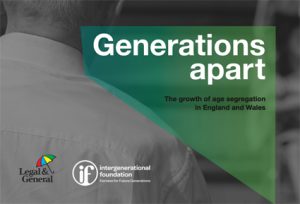David Kingman introduces “Generations Apart”, IF’s latest research project undertaken in partnership with Legal & General, which measures the growth of age segregation in England and Wales
Try to answer the following question: if you can imagine the neighbourhood where you live, is it full of people from different age groups, or are they mostly the same age as you? In a nutshell, this is what IF’s latest piece of research attempted to find out.
Why does age segregation matter?
This is an important question, because the bonds which tie society together are based on the hundreds of micro-interactions we have with our neighbours, when we walk past them in the street, queue behind them in shops, or ride alongside them on public transport. Even if we don’t socialise with our neighbours or form deep bonds with them, they make an important contribution to how we perceive different social groups.
This is one of the main reasons why geographers are concerned about segregation, because if we live in homogenous neighbourhoods where we don’t encounter people who are different from us on a day-to-day basis, then there’s a danger that we become more likely to form our perceptions of other social groups from the media and through hearsay, rather than thinking about them as real people. For example, multiple studies of public attitudes have shown that people tend to be the most hostile towards immigration in the areas which have the fewest migrants (see this example from Ipsos MORI), which suggests people are prone to absorbing negative stereotypes.
Certain forms of segregation have already been widely studied by other researchers, particularly those between different ethnic, class and national groups. However, segregation between different generations – age segregation – remains comparatively under-researched. Given IF’s concern with the growing divide between the generations in contemporary Britain, we wanted to see to what extent this has taken on a physical form.
How did we measure age segregation?
As the management guru Dr H. James Herrington is famous for saying, “If you can’t measure something, you can’t understand it.” That’s why geographers have invented tools that can enable us to reduce a complex phenomenon like segregation to a single number. In this case, the higher the number, the worse segregation has become.
The main tool which we used in this project was a device called the Index of Dissimilarity. If we’re comparing how two different groups are distributed across the neighbourhoods that make up a city, then the Index of Dissimilarity can tell us how many members of a particular group would need to move to a different neighbourhood in order for the two groups to be distributed evenly. The more people who would have to move, the more segregated it is. For example, in a fictitious city that was made up of 10 neighbourhoods where five of them were 100% white and the other five were 100% black, the Index of Dissimilarity would be 100 – indicating total segregation – even though the racial divide across the whole city is exactly 50/50.
We also used two other tools to measure age segregation: the Index of Isolation, which tells us for the typical person belonging to a particular group how many of their neighbours belong to the same group (which indicates how homogenous a neighbourhood is), and the Index of Interaction, which tells us what the chances are of a person who belongs to a particular group living in the same neighbourhood as someone from a different group. To return to the extreme case that was referred to above, a black person living in that city would have an Isolation Index score of 100 and an Interaction Index score of 0.
We then applied these tools to the neighbourhoods that make up the 25 biggest cities in England and Wales, which between them account for roughly half the country’s population. As we knew that cities tend to have a younger population profile than rural areas, we also wanted to see how the age profiles of urban and rural areas had changed in relation to each other, which we did by looking at the median ages of rural and urban neighbourhoods.
What did we discover? That will be explained in Part 2.
“Generations Apart” has been launched as a pamphlet in the Fluid Intelligence series sponsored by Legal & General [link]. To read the full in-depth research findings, you can also see the research report published by IF.
